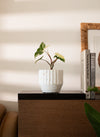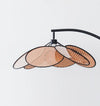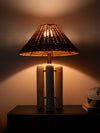Indoor plants have become the cornerstone of modern Indian home design, but the difference between a random collection of plants and a professionally styled green oasis lies in one crucial element: the right planters. Ceramic planters have emerged as the gold standard for serious plant enthusiasts and home decorators alike.
With 2025's interior design trends emphasising textures and visual richness, ceramic planters offer the perfect combination of functionality and aesthetics. Unlike plastic alternatives, ceramic planters provide the breathability plants need while contributing to your home's overall design narrative.
The Indian market has embraced this trend enthusiastically, with urban homes from Mumbai's compact apartments to Bangalore's spacious villas incorporating ceramic planters as essential design elements. But success with ceramic planters requires understanding which styles work best for Indian conditions and how to arrange them for maximum impact.
At Gharko, our Orbit Ceramic Planters represent the perfect marriage of form and function, designed specifically for Indian homes and lifestyles. Available in three coordinated sizes, they solve the common problem of mismatched planters that create visual chaos rather than harmony.
This comprehensive guide reveals professional plant styling techniques using ceramic planters, addressing the unique challenges of Indian climate, space constraints, and lifestyle needs. Whether you're starting your first indoor garden or upgrading existing plant displays, these strategies will help you create spaces worthy of design magazines.
1. Why Ceramic Planters Excel in Indian Conditions
Understanding why ceramic planters outperform alternatives in Indian conditions helps justify the investment and sets expectations for long-term success.
Climate Adaptation Benefits
Humidity Management: India's monsoon seasons create humidity levels of 70-90% in many regions. Ceramic's natural porosity allows excess moisture to evaporate, preventing root rot that commonly affects plants in plastic planters during humid months.
Temperature Regulation: Ceramic's thermal mass helps buffer extreme temperature changes common in Indian homes. During hot summers, ceramic planters keep soil cooler than plastic alternatives. During air-conditioned periods, they prevent rapid temperature shock to roots.
UV Resistance: Unlike plastic planters that become brittle and discoloured under intense Indian sunlight, ceramic planters maintain their appearance and structural integrity for decades.
The Science of Ceramic Benefits
Porosity Factor: Ceramic's microscopic pores allow air circulation to roots, essential for preventing the anaerobic conditions that cause root rot. This porosity also allows beneficial soil bacteria to thrive, improving overall plant health.
pH Neutrality: Ceramic planters don't leach chemicals into soil like some plastic alternatives, maintaining the neutral pH most houseplants prefer.
Weight Advantage: While heavier than plastic, ceramic's weight provides stability for taller plants in homes with ceiling fans, a common feature in Indian homes.
Aesthetic Longevity
Aging Gracefully: Quality ceramic develops patina over time that adds character rather than looking worn. This aging process aligns with the sustainable, long-term approach modern Indian households prefer.
Color Retention: Glazed ceramic planters maintain their colour and finish despite exposure to sunlight, moisture, and temperature fluctuations.
Style Versatility: Ceramic works equally well in traditional Indian homes and modern apartments, bridging design styles that plastic planters cannot.
Investment Analysis
Cost Per Year: While ceramic planters cost more initially, their 15-20 year lifespan versus 2-3 years for plastic planters makes them more economical long-term.
Real Numbers: A ₹800 ceramic planter lasting 15 years costs ₹53 annually. A ₹200 plastic planter replaced every 2 years costs ₹100 annually—nearly double the cost.
Resale Value: Quality ceramic planters retain value and can be gifted or sold, unlike plastic planters that become waste.
Health Benefits: Ceramic's breathability reduces fungal problems common in Indian humidity, leading to healthier plants with less need for fungicides or replacements.
Shop Gharko's Orbit Ceramic Planter Collection
2. The Art of Size Selection and Coordination
Professional plant styling depends on choosing the right planter sizes and understanding how they work together to create visual harmony.
The Professional Size Strategy
Small Planters (6-8 inch diameter):
Foundation pieces for herbs, succulents, and small houseplants. These create detailed layers in arrangements and work perfectly for kitchen herb gardens.
Ideal Plants: Basil, mint, cilantro, small pothos, air plants, small succulents
Best Placement: Countertops, shelving, windowsills, desktop arrangements
Styling Role: Provide texture and fill gaps in larger arrangements
Medium Planters (8-10 inch diameter):
The workhorses of indoor plant styling. Most houseplants thrive in this size range, making them perfect for living room and bedroom arrangements.
Ideal Plants: Snake plants, ZZ plants, peace lilies, medium palms, rubber plants
Best Placement: Side tables, plant stands, grouped floor arrangements
Styling Role: Create middle layer visual interest and serve as transition pieces
Large Planters (10-12+ inch diameter):
Statement pieces that anchor plant arrangements and provide dramatic height and presence.
Ideal Plants: Large snake plants, monstera, fiddle leaf figs, large palms
Best Placement: Floor corners, beside furniture, entryway statements
Styling Role: Anchor points that define spaces and create vertical drama
The Gharko Advantage: Coordinated Sizing
Our Orbit collection's three-size system eliminates guesswork. Each size proportionally relates to the others, ensuring harmonious arrangements regardless of how you combine them.
Professional Grouping Formulas
The Triangle Method: Use three planters in small, medium, and large sizes arranged in triangular compositions. This creates natural visual balance that appears professionally designed.
The Repetition Strategy: Use multiple planters of the same size with plants of different heights. This creates rhythm and flow while maintaining visual consistency.
The Gradient Technique: Arrange planters from largest to smallest (or vice versa) to create flowing transitions between spaces or furniture pieces.
Spacing Guidelines for Indian Homes
Small Spaces (studios, 1BHK): Focus on vertical arrangements using plant stands rather than floor space. Group 3-5 planters at different heights in one corner for maximum impact.
Medium Spaces (2-3BHK): Create 2-3 plant groupings throughout the home, using large planters as anchors with smaller planters for detail.
Large Spaces (4BHK+): Use plant arrangements to define spaces—entryway groupings, living room corners, bedroom sanctuaries.
Practical Considerations
Weight Distribution: Place largest ceramic planters directly on floors or structural elements. Use plant stands or tables for medium and small planters.
Watering Access: Ensure adequate space around planters for watering without moving them constantly. Ceramic's weight makes frequent repositioning impractical.
Growth Planning: Choose planters that accommodate 1-2 years of plant growth to minimise repotting frequency.
3. Plant Selection for Ceramic Planters in Indian Conditions
Success with ceramic planters depends on choosing plants that thrive in Indian conditions while providing the aesthetic impact you desire.
High-Success Plants for Indian Homes
Snake Plants (Sansevieria): The ultimate ceramic planter plant for Indian conditions.
-
Benefits: Extremely drought tolerant, handles air conditioning, thrives in low light
-
Ceramic Advantage: Weight stability for tall varieties, prevents tipping from ceiling fans
-
Styling Impact: Architectural lines complement ceramic's clean aesthetics
-
Care Requirements: Water monthly, tolerates neglect, perfect for busy professionals
ZZ Plants: Glossy, tropical appearance with minimal care needs.
-
Benefits: Drought tolerant, handles low light, glossy leaves look expensive
-
Ceramic Advantage: Medium-heavy plants benefit from ceramic's stability
-
Growth Pattern: Slowly develops into impressive statement pieces
-
Indian Performance: Thrives in air-conditioned environments, handles humidity fluctuations
Pothos Varieties: Fast-growing, forgiving, perfect for beginners.
-
Benefits: Rapid growth, easy propagation, excellent air purification
-
Ceramic Advantage: Trailing varieties look elegant cascading from ceramic planters
-
Variety Options: Golden pothos, marble queen, neon pothos for color variety
-
Styling Flexibility: Works in hanging planters or as tabletop trailing plants
Peace Lilies: Elegant flowering plants that signal healthy indoor environments.
-
Benefits: Beautiful white flowers, excellent air purification, thrives in humidity
-
Care Indicator: Droops when needs water, making care timing obvious
-
Ceramic Benefits: Heavy ceramic prevents tipping when plants get large
-
Indian Performance: Loves bathroom humidity, tolerates lower light
Plants to Avoid in Indian Ceramic Planters
Fiddle Leaf Figs: Too sensitive to environmental changes common in Indian homes.
Calathea Species: Require consistent humidity difficult to maintain in Indian homes.
Most Cacti: Ceramic's moisture retention can cause root rot in high humidity.
Seasonal Plant Strategies
Monsoon Season (June-September): Focus on humidity-loving plants like ferns, peace lilies, and pathos. Reduce watering frequency as ceramic retains more moisture.
Winter Season (December-February): Ideal time to establish new plants in ceramic planters. Plants experience less stress during cool, dry months.
Summer Season (March-May): Prioritise drought-tolerant plants like snake plants and ZZ plants. Ceramic's thermal mass helps protect roots from extreme heat.
Herb Garden Success in Ceramic Planters
High-Success Herbs: Basil, mint, cilantro, curry leaves, holy basil (tulsi)
Placement Strategy: Kitchen windowsills or under grow lights for year-round harvesting
Ceramic Benefits: Better drainage prevents herb root rot common with overwatering
Succession Planting: Replace herbs every 2-3 months for continuous fresh supply
Air-Purifying Plant Combinations
Create themed arrangements focusing on air purification:
-
Living Room: Large snake plant + medium peace lily + small pathos
-
Bedroom: ZZ plant + small snake plant + air plants
-
Office Space: Snake plant + pathos + small peace lily
Growth Management in Ceramic Planters
Repotting Timeline: Most plants need repotting every 2-3 years in ceramic planters due to better growth conditions.
Root Bound Signs: Plants drying out quickly, roots growing through drainage holes, stunted new growth.
Size Progression: Move plants up one ceramic planter size when repotting for continued growth.
4. Professional Styling Arrangements
Creating magazine-worthy plant arrangements requires understanding professional design principles adapted for Indian homes.
The Foundation: Triangle Arrangements
Professional plant stylists rely on triangular compositions because they create natural visual balance that appears intentional rather than accidental.
Basic Triangle Setup: Position three ceramic planters with different-sized plants to form an imaginary triangle. The largest plant anchors one corner, medium and small plants complete the triangle.
Advanced Triangulation: Create multiple overlapping triangles throughout a room for sophisticated flow that guides the eye naturally through the space.
Height Variation Strategies
The Rule of Threes: Use three distinct height levels in every plant grouping—floor level, table level, and elevated level.
Plant Stand Integration: Use wooden or metal plant stands to create additional height levels without requiring more floor space—crucial for Indian apartments.
Vertical Wall Gardens: Mount ceramic planters at different heights on walls to create vertical gardens that save floor space while adding dramatic impact.
Colour Coordination with Ceramic Planters
Monochromatic Approach: Use white or neutral ceramic planters throughout the home for visual consistency, letting plant colours provide variation.
Plant Colour Strategy: Choose plants with coordinated foliage colours—all deep greens, or mix variegated plants with solid greens for controlled variety.
Seasonal Colour Accents: Add flowering plants or colourful planters seasonally while maintaining neutral ceramic base collection.
Room-Specific Arrangement Strategies
Living Room: Create a main plant corner using large ceramic planters, supplement with smaller planters on side tables and shelves for layered abundance.
Bedroom: Focus on air-purifying plants in medium ceramic planters, position away from direct bed vicinity to avoid humidity issues.
Kitchen: Line up small ceramic planters with herbs along windowsills or under grow lights for functional beauty that supports cooking.
Balcony Transition: Use ceramic planters to create visual flow between indoor and outdoor spaces, choosing plants that can handle both environments.
Indian Climate Adaptations
Monsoon Preparation: Group ceramic planters where they can benefit from increased humidity without water logging. Move closer to windows during dry months.
Summer Heat Management: Position ceramic planters where they receive morning light but afternoon shade, protecting plants from intense heat.
Air Conditioning Considerations: Keep plants away from direct AC airflow while benefiting from overall temperature control.
Maintenance Access: Design arrangements that allow easy watering and pruning without disrupting the overall composition.
Ceramic planters represent more than just plant containers, they're foundational elements that transform ordinary houseplants into sophisticated design features. For Indian homes dealing with challenging climate conditions and space constraints, ceramic planters offer the perfect balance of functionality and aesthetics.
The key to success lies in understanding how ceramic planters work with Indian conditions rather than against them. Their natural porosity, thermal mass, and durability make them ideal for our climate extremes, while their timeless aesthetics complement both traditional and modern Indian home styles.
At Gharko, our Orbit Ceramic Planter collection embodies these principles. Designed specifically for Indian homes, each size coordinates perfectly with the others, eliminating the guesswork from plant styling. Whether you're creating your first plant corner or upgrading an existing collection, these planters provide the foundation for long-term success.
Remember that successful plant styling is a journey, not a destination. Start with quality ceramic planters and reliable plants, then build your collection gradually. Focus on creating one beautiful arrangement rather than filling every space with plants.
















